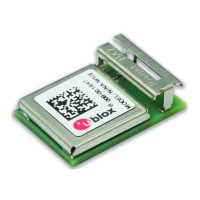NINA-W1 series - System integration manual
UBX-17005730 - R11 System description Page 9 of 55
C1 - Public
1.5 Supply interfaces
1.5.1 Module supply design (VCC)
NINA-W1 series modules include an integrated Linear Voltage converter that transforms the supply
voltage. The output of the converter, presented at the VCC pin, provides a stable system voltage.
1.5.2 Digital I/O interfaces reference voltage (VCC_IO)
NINA-W1 series modules include an additional voltage supply input for setting the I/O voltage level.
A separate VCC_IO pin enables module integration in many applications with different voltage supply
levels (1.8 V or 3.3 V for example) without level converters. NINA-W1 series modules currently support
3.3 V IO levels only.
1.5.3 VCC application circuits
The power for NINA-W1 series modules is applied through the VCC pins. These supplies are taken
from either of the following sources:
• Switching Mode Power Supply (SMPS)
• Low Drop Out (LDO) regulator
An SMPS is the ideal design choice when the available primary supply source is of a higher value than
the operating supply voltage of the module. This offers the best power efficiency for the application
design and minimizes the amount of current drawn from the main supply source.
⚠ When taking VCC supplies from an SMPS make sure that the AC ripple voltage is kept as low as
possible at the switching frequency. Design layouts should focus on minimizing the impact of any
high-frequency ringing.
Use an LDO linear regulator for primary VCC supplies that have a relatively low voltage. As LDO linear
regulators dissipate a considerable amount of energy, LDOs are not recommended for the step down
of high voltages.
DC/DC efficiency should be regarded as a trade-off between the active and idle duty cycles of an
application. Although some DC/DC devices achieve high efficiency at light loads, these efficiencies
typically degrade as soon as the idle current drops below a few milliamps. This can have a negative
impact on the life of the battery.
If decoupling capacitors are needed on the supply rails, it is best practice to position these as close as
possible to the NINA-W1 series module. The power routing of some host system designs makes
decoupling capacitance unnecessary.
For electrical specifications, refer to the appropriate NINA-W1 series data sheet [2] [3] [4].
1.6 System function interfaces
1.6.1 Boot strapping pins
There are several boot configuration pins available on the module that must be set correctly during
boot, or the module may not boot properly. Table 1 shows the condition of the bootstrap signals that
determine the behavior of the module during the system startup.
☞ Boot strap pins are configured to the default state internally on the module and must NOT be
configured externally, unless otherwise stated.

